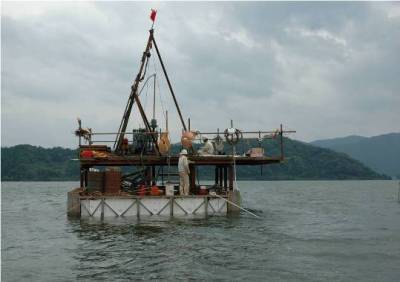The SG06 sediment core

 The sediment cores central to the "Suigetsu Varves 2006" project were collected in the summer of 2006 from the centre of Lake Suigetsu, at a water depth of approximately 34 m. The coring was undertaken using a hydro-pressure, thin-walled piston sampler, which was installed on a floating drilling platform. Sediment was obtained from four parallel bore-holes ("A", "B", "C", and "D") overlapping such that material from any given Lake Suigetsu sedimentary horizon would be represented by at least one of the individual sediment cores. In this way, a composite core (referred to as "SG06") of over 73 m was obtained, representing a continuous archive of palaeoenvironmental information spanning approximately the last 150,000 years.
The sediment cores central to the "Suigetsu Varves 2006" project were collected in the summer of 2006 from the centre of Lake Suigetsu, at a water depth of approximately 34 m. The coring was undertaken using a hydro-pressure, thin-walled piston sampler, which was installed on a floating drilling platform. Sediment was obtained from four parallel bore-holes ("A", "B", "C", and "D") overlapping such that material from any given Lake Suigetsu sedimentary horizon would be represented by at least one of the individual sediment cores. In this way, a composite core (referred to as "SG06") of over 73 m was obtained, representing a continuous archive of palaeoenvironmental information spanning approximately the last 150,000 years.
Each of the sediment core sections was extracted from its sampling tube within a few days of its recovery from the lake bottom. The cores were then immediately split into two half cylinders, and the freshly-exposed sediment surface digitally photographed, along with a depth scale, before any colour changes through oxidation could occur. Within each core section, layers with clearly identifiable characteristics were identified, ideally at 10 to 20 cm intervals, and defined at 1 mm precision using the depth scale of the digital images. Sub-sampling from the cores for multi-proxy palaeoenvironmetal analysis was subsequently undertaken using the 'double L channel' methodology of Nakagawa (2007).
The upper ~46 m of the Lake Suigetsu sediment profile demonstrates distinct lamination and represents sediment deposition spanning approximately the last 60,000 years. The underlying core section, from 46.01 to 63.75 m composite depth, is not laminated, and represents a time period when the lake was not deep enough to maintain anoxic bottom water conditions. Below 63.75 m, down to the base of the core at 73.19 m composite depth, the sediment is composed of alternating peat, inorganic clay layers, and occasionally finely laminated organic clays. This time period represents alternating fluvial and shallow water lacustrine environments that occurred after the initial tectonic formation of the basin.
A more thorough account of the sediment coring process, as well as a more detailed description of the SG06 core stratigraphy, is given by Nakagawa et al. (2012).

 The sediment cores central to the "Suigetsu Varves 2006" project were collected in the summer of 2006 from the centre of Lake Suigetsu, at a water depth of approximately 34 m. The coring was undertaken using a hydro-pressure, thin-walled piston sampler, which was installed on a floating drilling platform. Sediment was obtained from four parallel bore-holes ("A", "B", "C", and "D") overlapping such that material from any given Lake Suigetsu sedimentary horizon would be represented by at least one of the individual sediment cores. In this way, a composite core (referred to as "SG06") of over 73 m was obtained, representing a continuous archive of palaeoenvironmental information spanning approximately the last 150,000 years.
The sediment cores central to the "Suigetsu Varves 2006" project were collected in the summer of 2006 from the centre of Lake Suigetsu, at a water depth of approximately 34 m. The coring was undertaken using a hydro-pressure, thin-walled piston sampler, which was installed on a floating drilling platform. Sediment was obtained from four parallel bore-holes ("A", "B", "C", and "D") overlapping such that material from any given Lake Suigetsu sedimentary horizon would be represented by at least one of the individual sediment cores. In this way, a composite core (referred to as "SG06") of over 73 m was obtained, representing a continuous archive of palaeoenvironmental information spanning approximately the last 150,000 years.